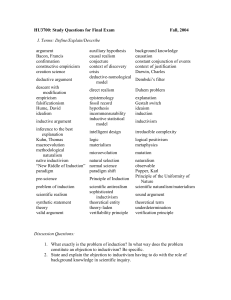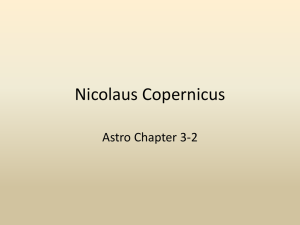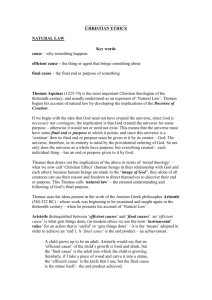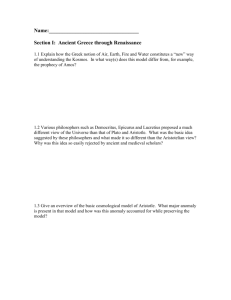HU3700: Exam 1
advertisement
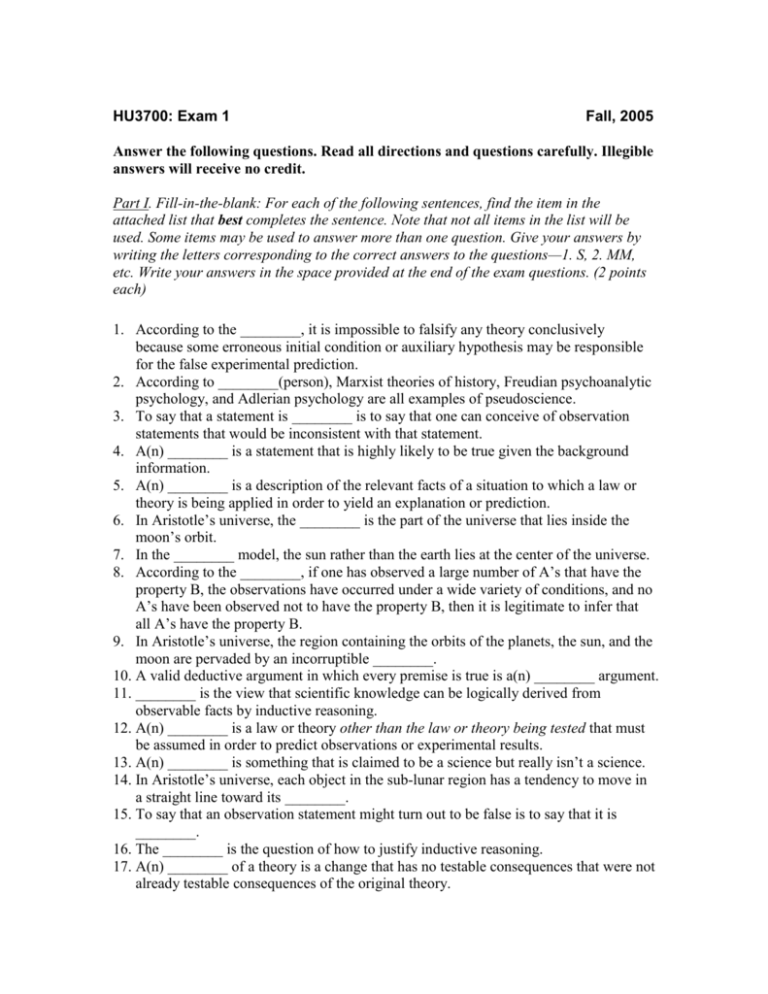
HU3700: Exam 1 Fall, 2005 Answer the following questions. Read all directions and questions carefully. Illegible answers will receive no credit. Part I. Fill-in-the-blank: For each of the following sentences, find the item in the attached list that best completes the sentence. Note that not all items in the list will be used. Some items may be used to answer more than one question. Give your answers by writing the letters corresponding to the correct answers to the questions—1. S, 2. MM, etc. Write your answers in the space provided at the end of the exam questions. (2 points each) 1. According to the ________, it is impossible to falsify any theory conclusively because some erroneous initial condition or auxiliary hypothesis may be responsible for the false experimental prediction. 2. According to ________(person), Marxist theories of history, Freudian psychoanalytic psychology, and Adlerian psychology are all examples of pseudoscience. 3. To say that a statement is ________ is to say that one can conceive of observation statements that would be inconsistent with that statement. 4. A(n) ________ is a statement that is highly likely to be true given the background information. 5. A(n) ________ is a description of the relevant facts of a situation to which a law or theory is being applied in order to yield an explanation or prediction. 6. In Aristotle’s universe, the ________ is the part of the universe that lies inside the moon’s orbit. 7. In the ________ model, the sun rather than the earth lies at the center of the universe. 8. According to the ________, if one has observed a large number of A’s that have the property B, the observations have occurred under a wide variety of conditions, and no A’s have been observed not to have the property B, then it is legitimate to infer that all A’s have the property B. 9. In Aristotle’s universe, the region containing the orbits of the planets, the sun, and the moon are pervaded by an incorruptible ________. 10. A valid deductive argument in which every premise is true is a(n) ________ argument. 11. ________ is the view that scientific knowledge can be logically derived from observable facts by inductive reasoning. 12. A(n) ________ is a law or theory other than the law or theory being tested that must be assumed in order to predict observations or experimental results. 13. A(n) ________ is something that is claimed to be a science but really isn’t a science. 14. In Aristotle’s universe, each object in the sub-lunar region has a tendency to move in a straight line toward its ________. 15. To say that an observation statement might turn out to be false is to say that it is ________. 16. The ________ is the question of how to justify inductive reasoning. 17. A(n) ________ of a theory is a change that has no testable consequences that were not already testable consequences of the original theory. 18. According to ________ (person), the same basic laws of physics apply to both the superlunar and sub-lunar regions of the universe.. 19. ________ is the area of philosophy that is concerned with the conditions and limits of human knowledge. 20. According to _________ (thesis), both falsification and confirmation of scientific theories play important roles in science. Part II. Answer two questions in Set A and two questions in Set B below (for a total of 4 questions). Indicate clearly which questions you are answering. Make your answers concise but complete. Avoid irrelevant discussion. Say exactly what you mean. Do not expect the grader to interpret your writing or to “read between the lines.” Write your answers on separate sheets. (15 points each) Set A 1. What are the reasons for believing that empirical facts are not entirely independent of theory? How can the acceptability of experimental results sometimes depend on a theory? Give an illustration of such dependence. 2. Compare and contrast explanation and prediction in science. In what respects are they similar? In what respects are they different? What type(s) of reasoning are involved in each? Give examples of each (explanation, prediction). 3. What exactly is inductivism? What are the main objections to that view? Be specific. Set B 4. How do falsificationists attempt to distinguish science from pseudoscience? What is the difference between saying that a statement is falsifiable and saying that it is false? Illustrate with an example. 5. What are the main differences between sophisticated falsificationism and the original (Popperian) version of falsificationism? What difficulties with the original version was sophisticated falsificationism intended to correct? Explain how it attempted to correct them. Be specific. 6. What was the Copernican revolution? When did it occur? Why did it take so long for it to be completed? How do critics of falsificationism use the history of the Copernican revolution to make their case? Be specific. Below is the list of terms for Part I. Note that the items are in alphabetical order. A. B. C. D. E. F. G. H. I. J. K. ad hoc modification analyze argument Aristotle auxiliary assumption bold conjecture causation cautious conjecture confirmation conjecture Copernican revolution L. Copernicus M. deductive N. dogmatism O. Duhem/Quine thesis P. empiricism Q. epicycle R. epistemology S. ether T. evaluate U. experiment V. experimental outcome W. experimental setup X. explanation Y. extraneous Z. fact AA. BB. fallible falsifiability, degrees of CC. falsifiable DD. falsificationism EE. falsificationism FF. falsificationist criterion of science GG. form HH. Galileo II. geocentric (Ptolemaic) JJ. heliocentric (Copernican) KK. hypothesis LL. induction MM. inductivism NN. initial condition OO. Kepler, Johannes PP. law QQ. logic RR. natural place SS. Newton, Isaac TT. objective UU. observation statement VV. parallax WW. XX. YY. ZZ. perceptions Popper, Karl prediction principle of induction AAA. problem of induction BBB. pseudoscience CCC. relevant fact DDD. revisable EEE. scientific progress FFF. senses GGG. singular statement HHH. sophisticated falsificationism III. sound JJJ. sub-lunar region KKK. super-lunar region LLL. theory MMM. theory-dependent NNN. Tower argument OOO. universal statement PPP. valid QQQ. verification Part I Answers: 1. 6. 11. 16. 2. 7. 12. 17. 3. 8. 13. 18. 4. 9. 14. 19. 5. 10. 15. 20.
